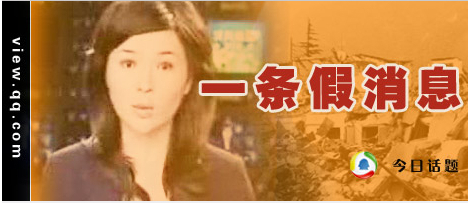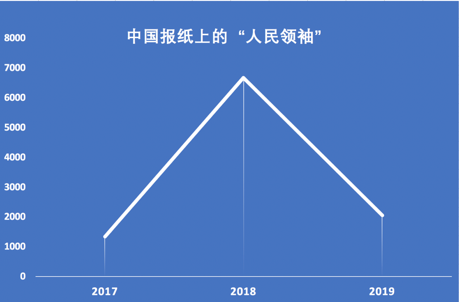Is it against Chinese law to be callous and pigheaded?
By David Bandurski — China’s latest case of the “human flesh search engine” (人肉引掣) at work has landed a 17-year-old girl in police detention, and that has some Chinese asking: is this really a matter of broad social concern, and is there any legal basis for police intervention? [Frontpage Image: Screenshot of controversial video in yet another Internet mob case back on May 20, 2008]
This time, the “engine” has turned against a girl from the city of Xinyi in Jiangsu Province, who, according to news reports that give her month and year of birth, should not be a legal adult until next November. While many people — and certainly millions of Web users — found her insensitive comments on the Sichuan earthquake unacceptable, a few columnists have stepped out in the last two days to question the handling of the case by authorities.
The following editorial from RedNet, which appeared yesterday on QQ and other major web portals, questions the legal basis for the administrative detention of the Jiangsu girl, and argues for a clearer understanding of the differences between the public and private domains.
On What Basis is the Girl Who Cursed the Disaster Victims Being Detained?
By Yu Lisheng (于立生)
Finding herself at odds with a web user from Sichuan, a girl from the city of Xinyi in Jiangsu Province wrote a post called “Thank Goodness for the Earthquake in Sichuan” on her personal QQ space, in which she mocked the victims of the Wenchuan earthquake. On June 5 police administratively detained this girl.
When I heard this news I was really shocked. I was shocked first of all by this girl’s remarks, which were truly ignorant and lacking in conscience. Secondly, I was shocked by the fact that – though what she said was doubtlessly wrong – she could be found guilty on the basis of her words and detained by police for three days, which seemed to me a bit uncalled for.
I believe that our freedom of thought (思想自由) is absolute, not subject to any restrictions, as this is purely our personal domain. Freedom of expression and freedom of movement, on the other hand, which can potentially impact larger society, should be correspondingly restricted, subject to greater limitations arising from law or from moral codes. And so we should be responsible for speech and actions exercised in the public domain.
This girl, because she spoke incorrectly, has been administratively detained by police for three days; and the reason the police cite is “danger to society.” Article 2 of the Law of the People’s Republic of China on Penalties for Administration of Public Security (中华人民共和国治安管理处罚法) states that: “Whoever disturbs social order, endangers public safety, infringes upon a citizen’s rights of the person and encroaches upon public or private property, if such acts constitute a crime according to the Criminal Law of the People’s Republic of China, shall be investigated for criminal responsibility; if such acts are not serious enough for criminal punishment but should be given administrative penalties for public security, penalties shall be given according to these Regulations.”
But we must be clear that this girl’s wrong remarks were expressed in a QQ.com space, which is to say in a space where the lines between the private and public domains are a matter of some controversy. Let’s say someone is standing on his own doorstep – not quite inside, but not on the street either – and they shout out something vile. How damaging is this to society? If Internet users had not issued an “online wanted poster” (网络通缉) and started up the “human flesh search engine” (人肉引掣) how much attention would have been paid to this ordinary girl in her personal QQ space? What kind of effect does this really have on society?
If we go by this way of thinking, then we can say that this sort of behavior is wrong, just like cursing on the streets — but should it result in administrative detention?
Secondly, according to news reports, this girl was born in November 1990, so she is not yet 18 years old. But Article 21 of the Law of the People’s Republic of China on Penalties for Administration of Public Security stipulates that: “Under one of the following circumstances, the penalty of administrative detention shall not be executed against the person who has committed an act against the administration of public security, although such a penalty should be imposed on him/ her according to the provisions of this Law: (1) The person has attained to the age of 14 but not to the age of 16; (2) The person has attained to the age of 16 but not to the age of 18, and such act is committed for the first time.”
So we must ask: what is the legal basis for the police imposition on this girl of three days of administrative detention?
This girl definitely said the wrong thing. But morals are morals, and laws are laws. We can criticize her and educate her. We can call her morals into question. But we must not confuse the lines here, overstepping the law. Voltaire once said: “I disapprove of what you say, but I will defend to the death your right to say it.” What I mean to say is: “I firmly disapprove of this girl’s ignorance and her rash words lacking conscience, but I must defend the legal rights of this girl who “has attained to the age of 16 but not to the age of 18” not to be administratively detained.
When dealing with underaged children, I’m afraid, “Learning from past mistakes to avoid future ones, and curing an illness to cure the patient,” are much more valuable methods than, “Beating them to death with a single swing of the club.”
[Posted by David Bandurski, June 10, 2008, 2:35pm HK]
———————
As of 2:36pm, June 10, 2008, the above editorial on QQ had drawn more than 20,000 comments from Web users. We include a few below, in the original:
评论首页 >> 新闻 >> 综合新闻
123456下一页最末页
来自:117.23.96.* 2008-06-09 08:49:45[热帖]腾讯网友:
[对你发表的的文章表示不满]
四川发生大地震,牵动全中国人民的心,在这种情况下我们要团结要爱护自己的同胞,而不是吃里爬外,如果,你的家人失去了,别人诅咒你的家人,你会高兴吗???我想你不会,那个女人的做法已经说明他不配做中国人,我个人感觉拘留的对。如果,我们不及时采取措施我想骂人的会接二连三的出现!你要不满你可以告执法单位啊,在这说有什么???最看不起就是你们这种动笔不做事情的人。
回复 支持(1978)反对(1310) 参与辩论(75)
来自:十堰市 2008-06-09 08:53:31[热帖]杰 [等级一]:
看到被拘留的消息.感觉是还法制社会呢?悲哀啊!看来离法制社会还远的很啊,就因为惹了众怒就能拘留.赞同楼主所说的拘留的理由就是依据是什么?没依据就只能口头教育,不能拘留.一个孩子而已没必要一棒子打死.年少无知能有几多人年少时候没无知荒唐过?对那些想叫人家死坐牢的人,别以为你叫嚣几句你就爱国,国家不是你这种爱法,我们可以批评教育小女孩,但不能做过了毕竟她是个孩子
回复 支持(1751)反对(886) 参与辩论(53)
来自:杭州市 2008-06-09 08:39:53[热帖]腾讯网友:
[你是中国人吗,什么是法,法是立在什么之上的?]
好像很有材一样的,搞的多大学问一样,不懂就不要乱叫,像这样的情节我觉得3天太少,最少拘留也要15天,你这样的人我看也该拘留个15天. 能拘留她还找不到法律条文吗,哎!有这个精力去多支持一下灾区人民,在这儿打什么抱不平,你以为你是谁呀,想成名也别这样叫,实在没事做,买几本法律书看一下!
回复 支持(1074)反对(900) 参与辩论(27)
来自:黑河市 2008-06-09 08:41:20[热帖]津搏 [等级一]:
作者先生,中国就你一个人懂法吗,在这卖弄啥!
回复 支持(437)反对(555) 参与辩论(15)
来自:江苏省 2008-06-09 08:37:38[热帖]腾讯网友:
道德、法律不应混为一谈。
回复 支持(700)反对(27) 参与辩论(10)
来自:59.111.32.* 2008-06-10 13:53:40腾讯网友:
[本案现在影响危害更大!]
小女人和该公安局都犯了不计后果的严重错误!都该逮捕!!
回复 支持(0)反对(0) 查看回帖(0)
来自:北京市 2008-06-10 13:48:48苦咖啡 [等级一]:
不同意作者的观点。个人认为,该抓!
回复 支持(0)反对(0) 查看回帖(0)
来自:123.190.131.* 2008-06-10 13:48:18腾讯网友:
无论她在家里还是在家外,还是在自己的空间里,只要她做了危害社会的事,不道德的事,都应受到惩罚,骂天天惩,骂人人罚,法律是为道德护航的,我认为我国的法律在有些方面还欠缺,就应该把骂人者,割掉舌头。
回复 支持(0)反对(0) 查看回帖(0)
来自:59.111.32.* 2008-06-10 13:46:00腾讯网友:
内外一样美的女人!教育宽容才能社会和谐啊!!!
回复 支持(1)反对(0) 查看回帖(0)
来自:125.71.99.* 2008-06-10 13:39:26腾讯网友:
[情理就是法]
拘留它是有依据的,伤害全国人民的感情,侮辱灾区人民,判它50年也有依据,法不外乎情理,请那些装神弄鬼、哀叹中国无法治的假道学们搞清楚,法制的基本精神就是大众的感情和道德,没文化不是你们的错,没文化还要乱发帖子就是你们的错了
回复 支持(0)反对(1) 查看回帖(0)
来自:深圳市 2008-06-10 13:36:46腾讯网友:
[又一个为出名而显摆的人]
请问作者对法律又了解多少,不要显摆自己了.
愚蠢
回复 支持(0)反对(0) 查看回帖(0)
来自:成都市 2008-06-10 13:35:36无心 [等级一]:
敢问公安机关对这名女孩施以治安拘留3日的处罚,法律依据何在呢?
你懂不懂什么是“依照本法应当给予行政拘留处罚的,不执行行政拘留处罚”
我给你解释,不执行行政拘留并不是说不给予行政拘留处罚了,这句话的意思是如果行为人已满十六周岁未满十八周岁,初次违反治安管理处罚法,应当给予行政拘留处罚的,行政拘留处罚要给,只是不送到拘留所执行罢了。
… [查看全文]
回复 支持(1)反对(0) 查看回帖(0)
来自:222.210.180.* 2008-06-10 13:28:04风雨消歇 [等级一]:
拘留三天太少了!让她学会做人我觉得至少得一辈子
回复 支持(0)反对(2) 查看回帖(0)
来自:金华市 2008-06-10 13:26:17腾讯网友 [等级一]:
[依据]
于老大:你要依据么?这世界有多少事情是没有依据的?!这世界有多少事情是有依据的?!说的清或说不清重要与否本身就是个问题.所以不要用这个话题来哗众取宠、博取名利,大家都只是凭着一点血性、一点人性、一点品性说话办事就OK了!
回复 支持(0)反对(1) 查看回帖(0)
天涯浪子 [等级一]:
拘留3天不为过
回复 支持(2)反对(0) 查看回帖(1)
来自:景德镇市 2008-06-10 09:52:57腾讯网友:
执法者应依法办事,不能为所欲为,否则 被拘人有权提出申请国家赔偿,
回复 支持(3)反对(0) 查看回帖(0)
来自:天津市 2008-06-10 09:50:56腾讯网友:
教育的悲哀。在目前法律还不健全,人的道德水准还没有达到一定层次时候,非常时期就应如此对待,拘留的对。十七岁已不是孩子了,和那些救灾的解放军年龄差不多,她又在做什么!(可耻)战士们在用生命救人,可她在亵渎生命。作者先生你可能已为人父母,教育孩子是应该的,但要看多大的孩子,在灾区和这个女孩同龄的孩子有的在念书,有的已经担起了一个家的责任。在法律的案例中也有骂人致死的,难道骂人无罪吗?作为中国人作… [查看全文]
回复 支持(1)反对(0) 查看回帖(0)
来自:河北省 2008-06-10 09:47:10腾讯网友:
想当初,N多人辱骂河南人民,现在都颤抖了吧!个个拘你们三天!哼哼!
回复 支持(0)反对(0) 查看回帖(1)
来自:自贡市 2008-06-10 09:48:31腾讯网友:
[打个比方]
同样是贪污,为什么贪污救灾款会被处罚的更重。同样是骂人,为什么在这个时候辱骂灾区人民会被拘留的原因了。楼猪稍稍动动你的猪脑子就明白了。真希望中国少出现这样的楼猪。
回复 支持(1)反对(2) 查看回帖(0)
来自:福州市 2008-06-10 09:48:06孑立 [等级一]:
不给点教训以后不会明白的
让她长点见识
回复 支持(1)反对(0) 查看回帖(0)
来自:吉林市 2008-06-10 09:46:20管教员 [等级一]:
[不正常的人]
不正常的人无论何时何地都是存在的,不要大惊小怪。
回复 支持(0)反对(0) 查看回帖(0)
来自:长春市 2008-06-10 09:46:07腾讯网友:
[完善法律吧]
我们的国家需要彻底地完善法律制度,她毕竟是个未成年女孩,不满18,其行为没有犯法,应说服教育,她也是祖国的未来呀~
[引用] 117.23.96.* 的腾讯网友发表于 2008-06-09 08:49:45
四川发生大地震,牵动全中国人民的心,在这种情况下我们要团结要爱护自己的同胞,而不是吃里爬外,如果,你的家人失… [查看全文]
回复 支持(2)反对(2) 查看回帖(0)
来自:镇江市 2008-06-10 09:39:33腾讯网友:
作者太天真了,那些执法的人有几个守法的.我们国家的法律还要健全啊,有太多的人凌驾与法律之上啊
回复 支持(2)反对(0) 查看回帖(0)
来自:222.210.215.* 2008-06-10 09:37:30[热帖]大立广告制作 [等级一]:
我认为这不是一棍子打死,只不过是三天而已,作者也不至于就戴这么大顶帽子。我个人认为不能只是口头教育就能了事,我相信作者和我一样对法律都不精通,但事实上,她的言论是放在全世界都能看到的地方,她的言论是伤害到了所有善良人的心,他的言论已经从事实上造成了危害,不仅仅是一个“错”字就能敷衍的。对她的处罚是让她能明是非、知良耻,以后不能任性枉为。处罚力度也合适,不能太轻,仅口头教育不足以让其有切肤之痛… [查看全文]
回复 支持(5)反对(0) 查看回帖(0)








